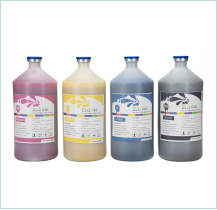
The main reasons for the blockage of the printer nozzle are as follows:
I. Ink-related reasons
1. Poor ink quality:
• Poor quality ink is used, which may contain too many impurities, pigments with large particles, etc. These impurities gradually accumulate in the nozzle and easily clog the nozzle. For example, some cheap non-original inks may not be strictly filtered during the production process, resulting in tiny solid particles in the ink.
• Mixing inks of different brands or models. Due to the different components and characteristics of different inks, chemical reactions may occur after mixing, resulting in precipitation, which in turn clogs the nozzle. For example, the additives in one ink react with the dye of another ink to form insoluble substances.
2. Ink drying:
• If the printer is not used for a long time, the ink in the nozzle will gradually dry up, especially in a dry environment, the drying speed will be faster. The dried ink will form lumps at the nozzle and clog the nozzle. For example, in the hot and dry summer, if the printer is not used for more than a month, the nozzle is likely to be clogged due to ink drying.
• The printer suddenly loses power during printing or the ink cartridge is improperly installed, causing the nozzle to be partially exposed to the air, which can easily cause the ink to dry and clog the nozzle.
2. Improper operation
1. Frequent power on and off: Frequently turning the printer on and off will cause the nozzle to undergo multiple heating and cooling processes in a short period of time. This may cause the ink to have poor fluidity in the nozzle and easily cause precipitation and clogging. For example, some users turn the printer on and off multiple times in a short period of time in order to save electricity, which will cause greater damage to the nozzle.
2. Sudden interruption during printing: If the power is suddenly unplugged during printing, the paper is stuck and not handled in time, etc., the ink pressure in the nozzle will change instantly, which may cause the ink to solidify in the nozzle or clog the nozzle hole.
3. Improper paper selection: Use poor quality, rough surface or impurity paper for printing. Fibers, dust, etc. on the paper may enter the printer during printing and clog the nozzle. For example, some cheap copy paper may contain more paper scraps, which are easy to fall off and enter the printer during printing.
3. Environmental factors
1. Temperature and humidity:
• Ambient temperature that is too high or too low will affect the performance of the ink. When the temperature is too high, the viscosity of the ink will decrease, and it is easy to evaporate and dry, clogging the nozzle; when the temperature is too low, the fluidity of the ink will deteriorate, which may also cause clogging. For example, in the hot summer, if the printer is placed in a room without air conditioning, the risk of nozzle clogging will increase.
• If the ambient humidity is too low, it will accelerate the drying of the ink; if the humidity is too high, it may cause the inside of the printer to be damp, affecting the electrical performance, and it may also cause the ink to deteriorate and clog the nozzle. Generally speaking, the relative humidity of the printer's working environment should be kept between 40% and 60%.
2. Dust and impurities: If the printer is placed in a dusty environment, dust may enter the printer, adhere to the surface of the nozzle or enter the nozzle hole, causing clogging. For example, if the printer is used near some construction sites or in rooms that are not cleaned frequently, dust has a greater impact on the nozzle.